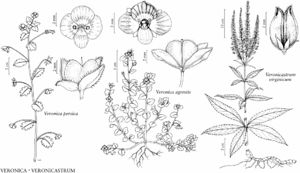Veronica agrestis
Sp. Pl. 1: 13. 1753.
Annuals. Stems creeping to decumbent, 5–25 cm, hairy. Leaves: blade elliptic-ovate to oblong, (6–) 8–16 (–19) × (3–) 4–10 (–13) mm, base truncate, margins serrate, teeth 4–6 (–8) per side, apex obtuse to acute, abaxial surface ± more densely hairy than adaxial. Racemes 1–5, terminal, 50–250 mm, 5–15-flowered, axis eglandular-hairy, sometimes glandular-hairy; bracts elliptic-ovate to oblong, (6–) 9–16 (–19) mm. Pedicels deflexed, (5–) 6–10 (–15) mm, ± shorter than subtending bracts, densely eglandular and, sometimes, glandular-hairy distally. Flowers: calyx lobes linear-lanceolate, (5–) 6–7 mm, 2.2–2.6 mm wide, apex rounded, sparsely eglandular or glandular-hairy; corolla white or pale pinkish or pale blue, 4–5 (–6) mm diam.; stamens 0.5–1 mm; style (0.6–) 0.9–1.1 (–1.2) mm. Capsules ± compressed in cross-section, ± subglobular, 3.5–4.5 (–4.7) × 4.5–6 (–6.3) mm, apex emarginate, sparsely glandular-hairy. Seeds 6–14, yellow to ochre, globular, cymbiform, 1.3–2.1 × 1–1.6 mm, 0.6–1.1 mm thick, strongly rugose (transversely ribbed). 2n = 28 (Europe).
Phenology: Flowering May–Oct.
Habitat: Light, noncalcareous, moist soils, gravelly soils.
Elevation: (0–)300–800 m.
Distribution
Introduced; Nfld. and Labr. (Nfld.), N.S., Que., D.C., Fla., Ill., La., Mass., N.Y., Pa., Tex., Vt., Europe
Discussion
Veronica agrestis is similar to the more frequent V. persica and probably frequently overlooked and to be expected elsewhere. However, it should be noted that it is less common than V. persica or V. polita and always in more humid habitats.
Selected References
None.
